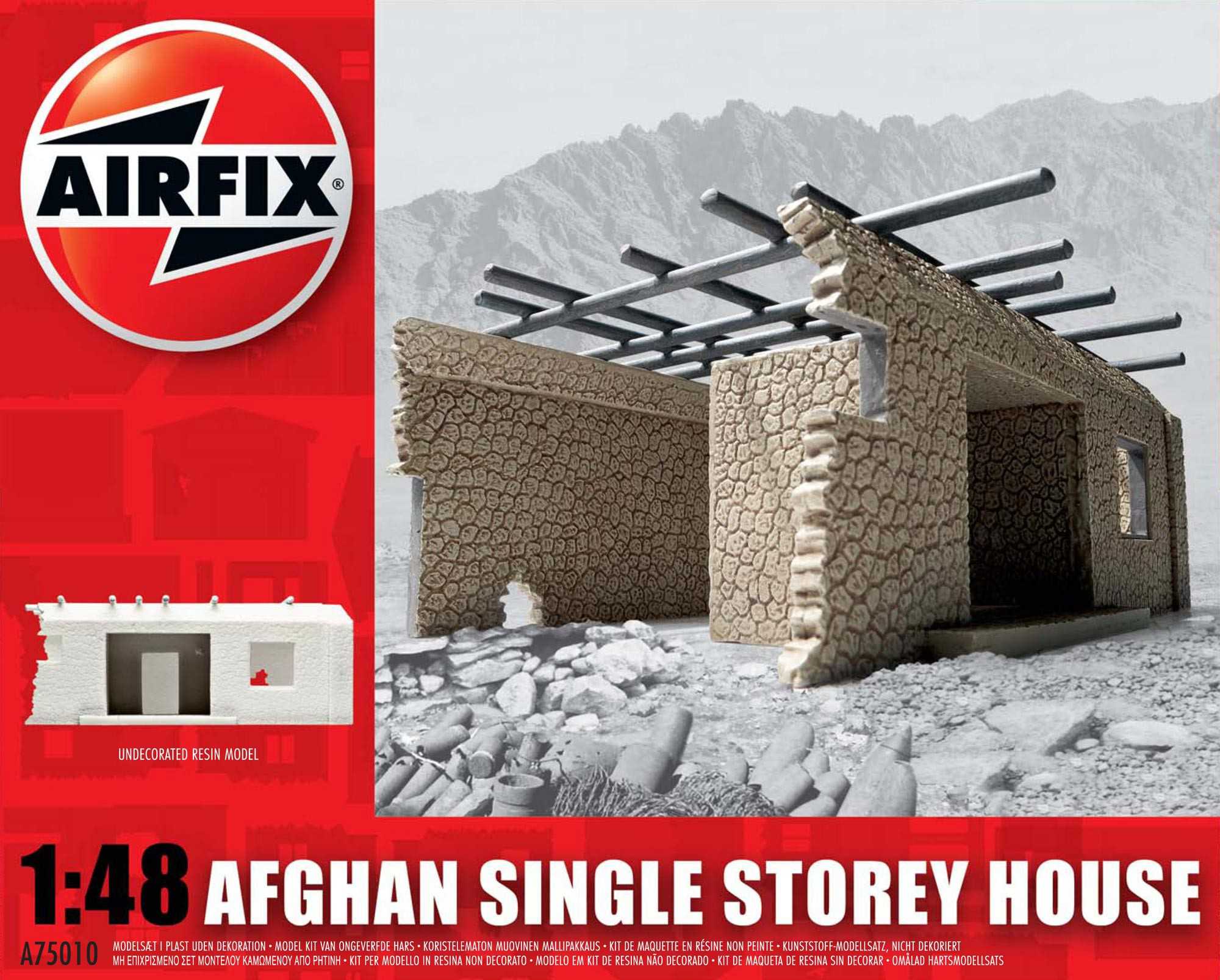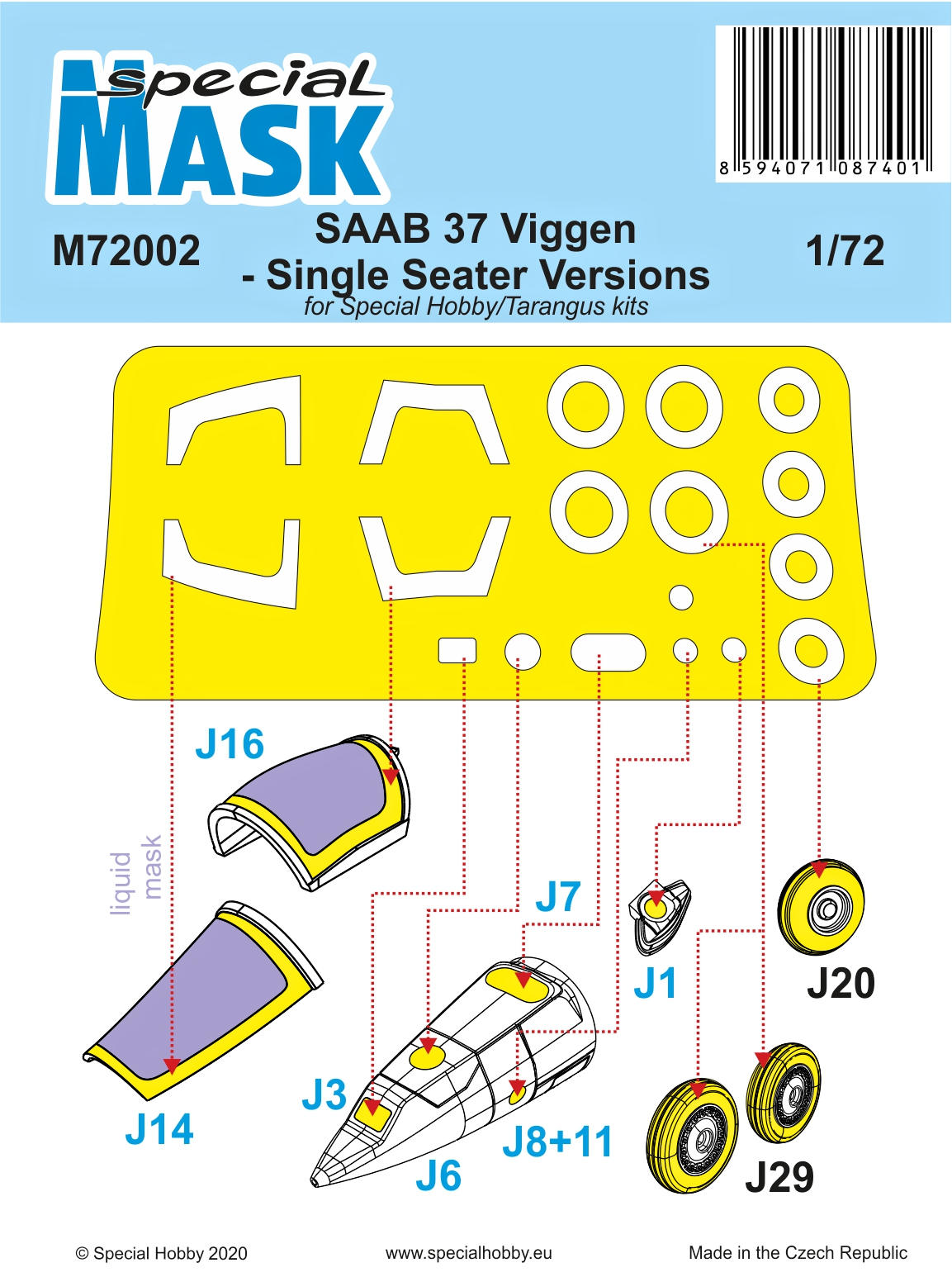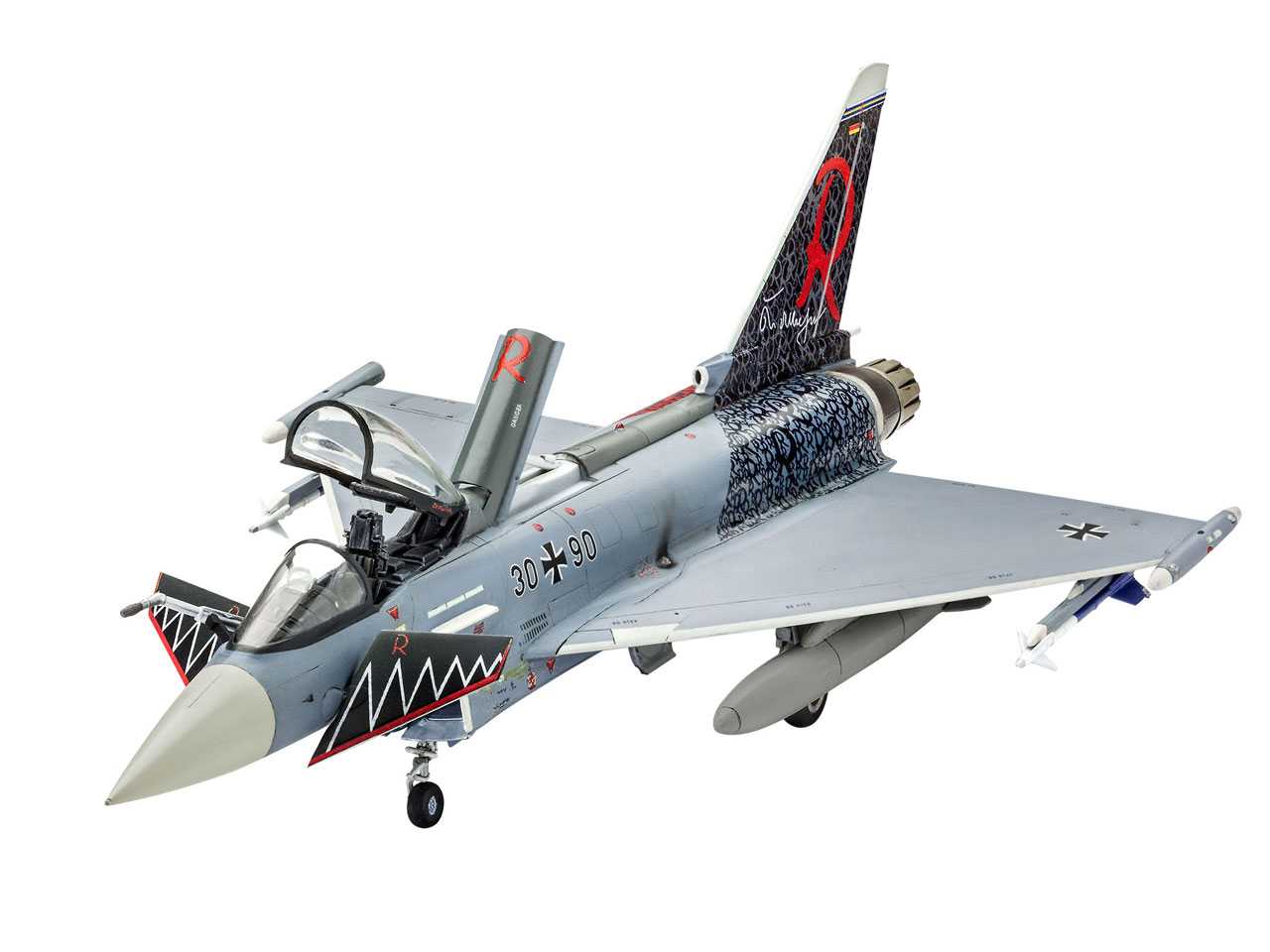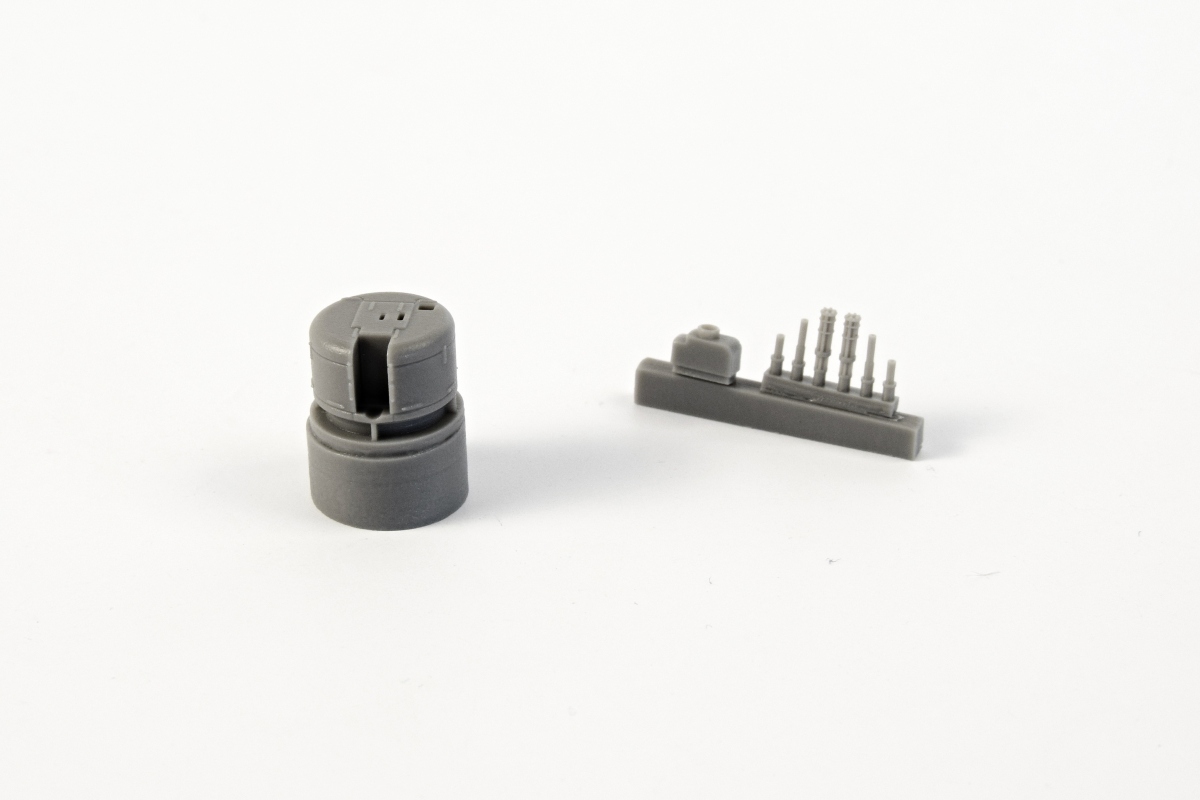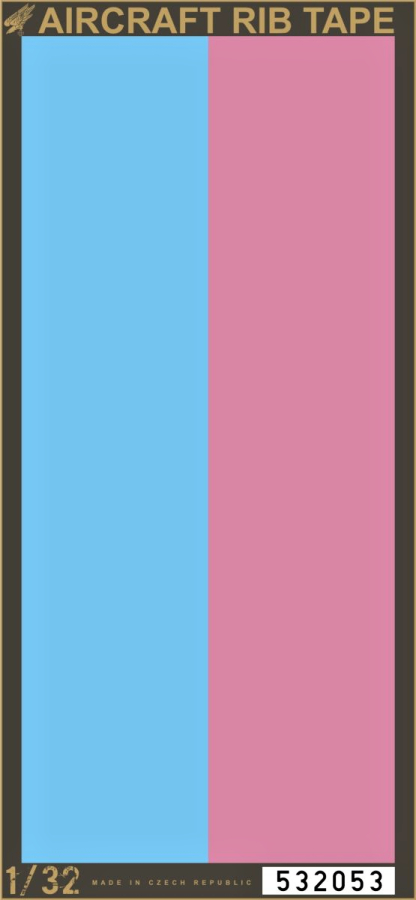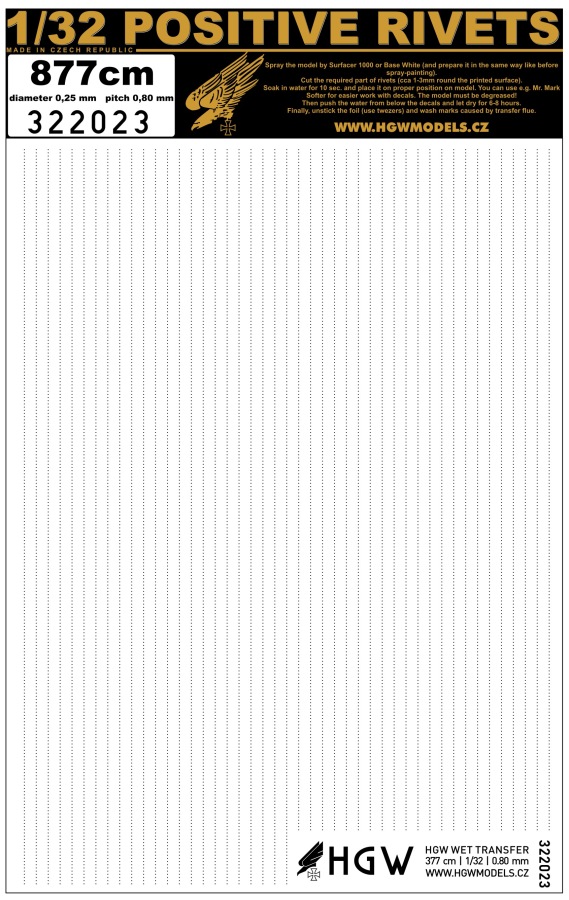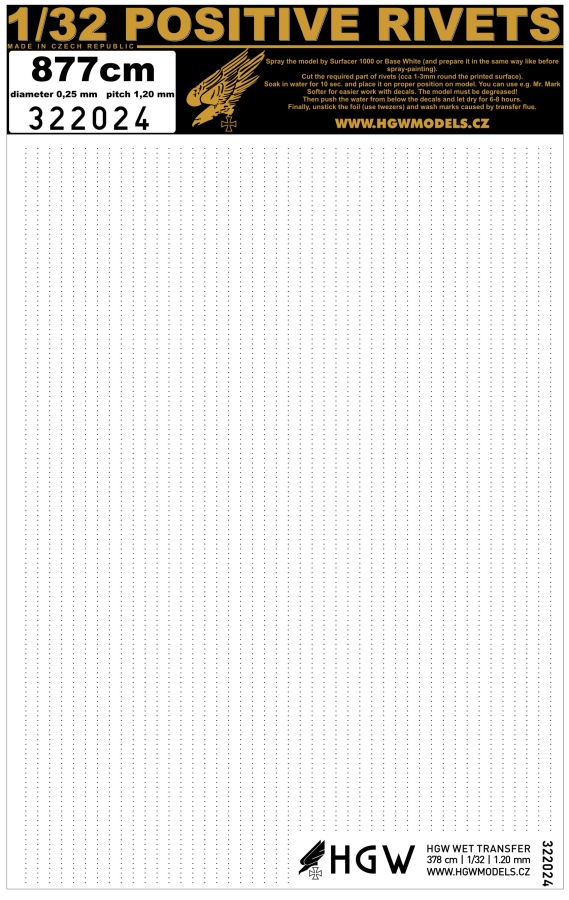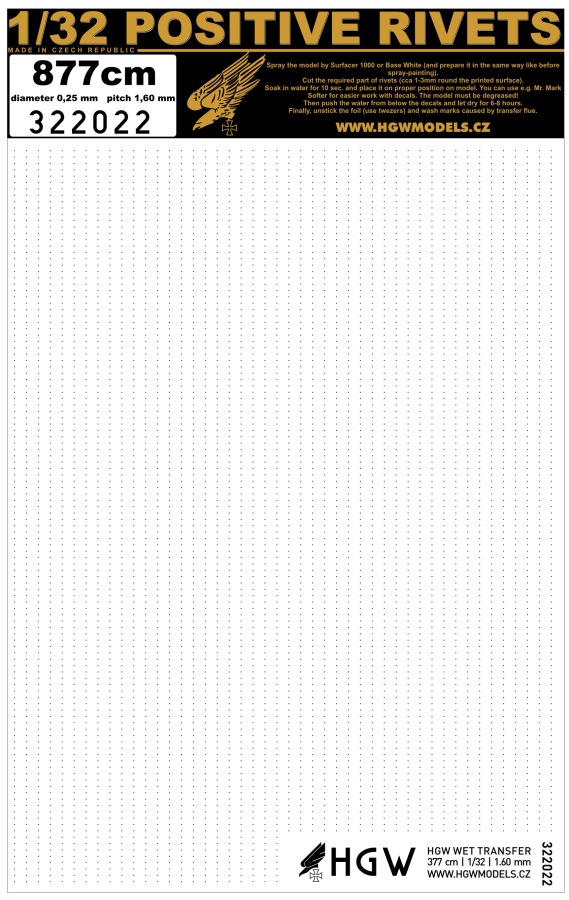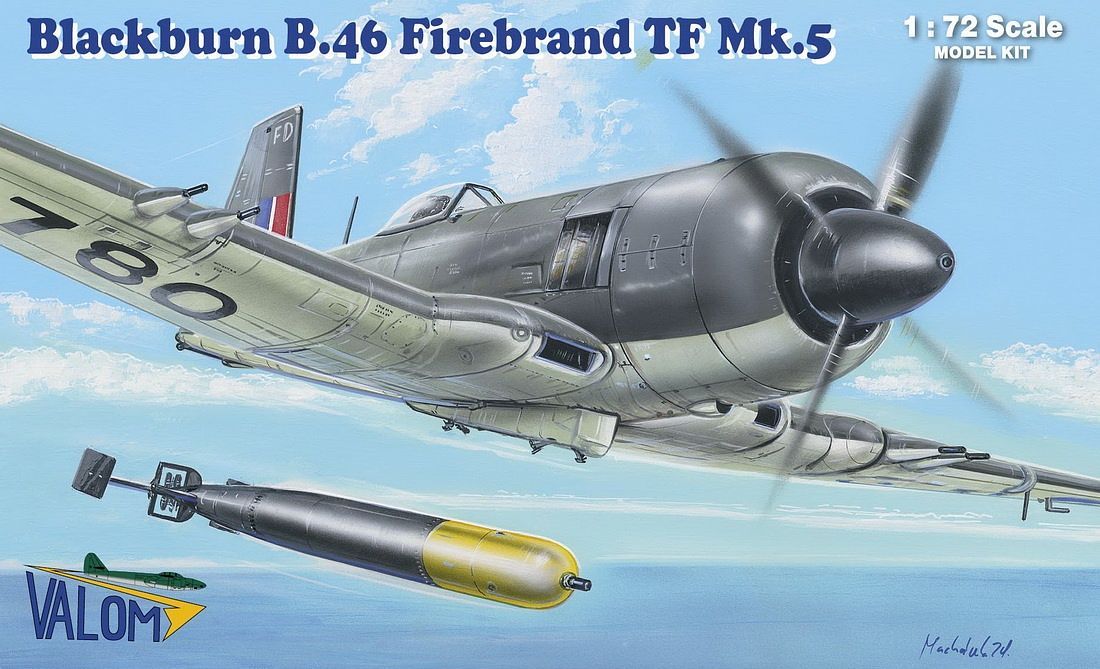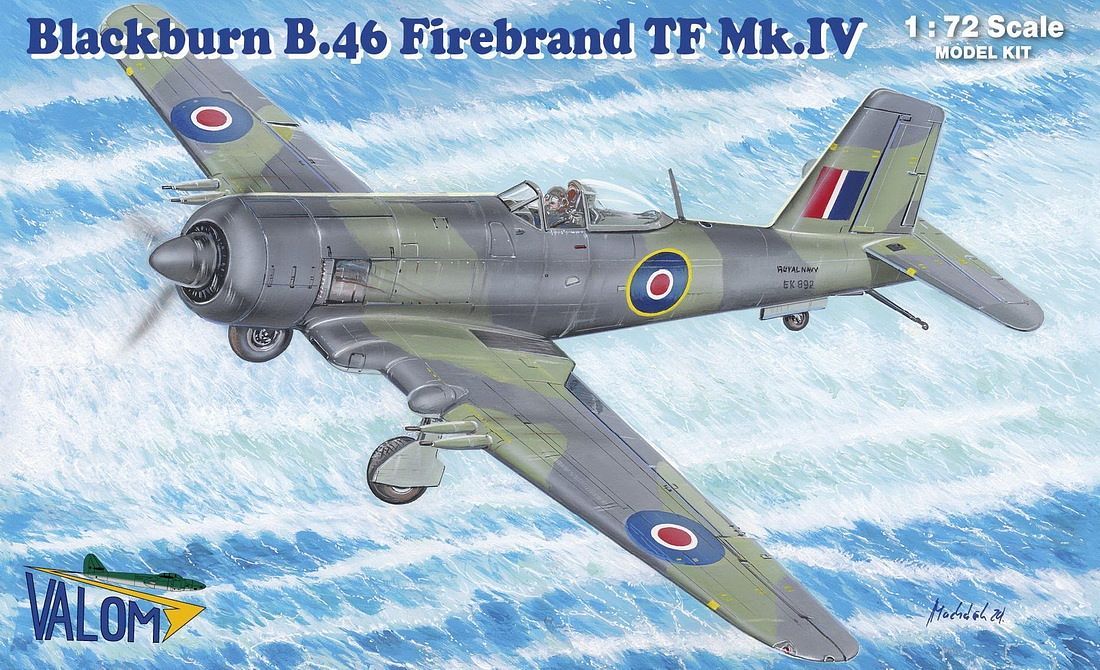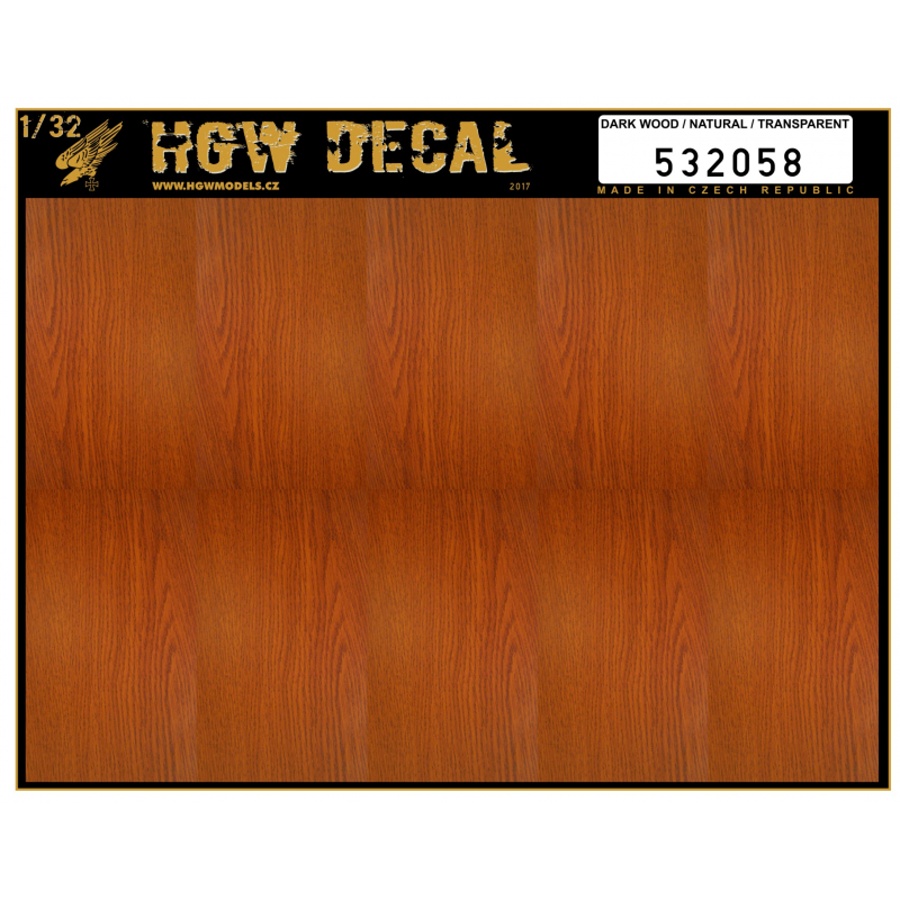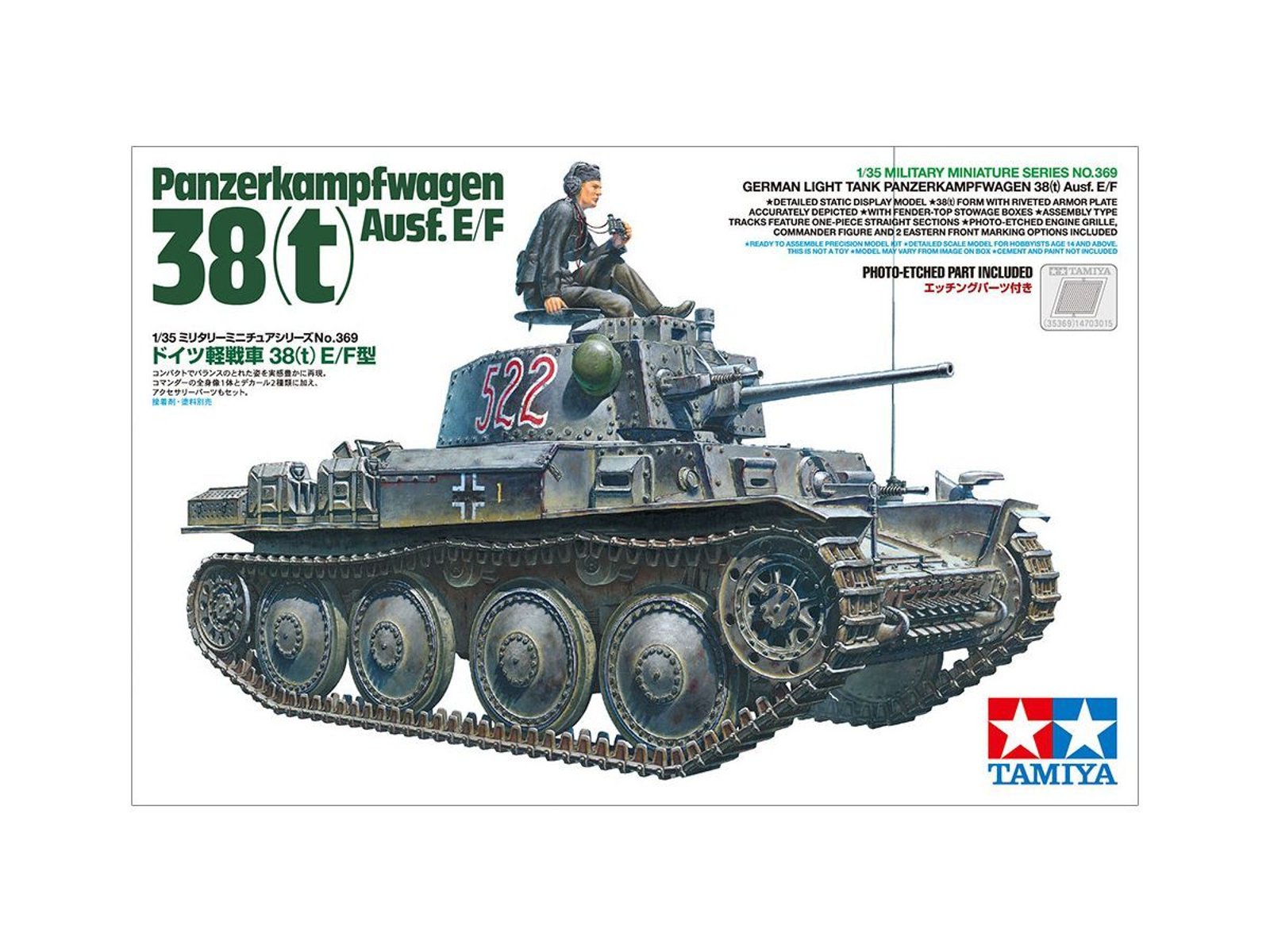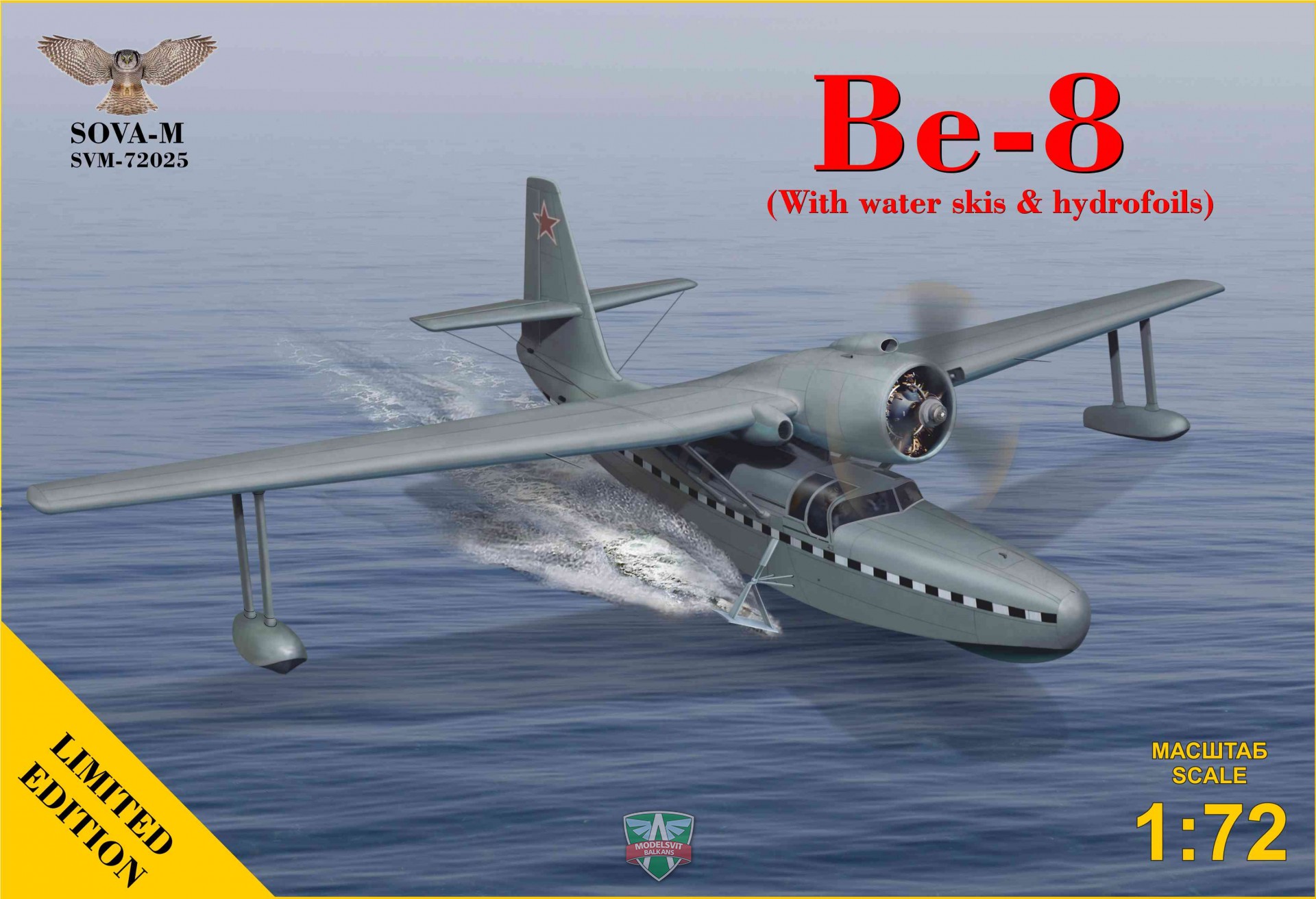Modely
Celkem 74 produktů
1/48 Avia BH-9 „Boska“ Single-Seater. Avia BH-9 byl československý dolnokřídlý jednoplošník, který se používal jako cvičný a turistický letoun. Slavil úspěchy v mnoha závodech a získal několik rekordů i na dálkových tratích. Letouny používané v armádě nesly označení Avia B-9. Specifikace modelu: měřítko: 1:48, rozpětí: 202 mm, délka: 138 mm, počet kamuflážních schémat: 3, obtížnost: 3. Potřebné barvy Humbrol: Cream, Aluminium, Brick Red, Brown, Wood, Black, Dak Earth, Dark Green, Ochre. Nutno dokoupit: barvy, lepidlo na plastikové modely, ředidlo, štětce.
1/48 Avia BH-9 „Boska“ Single-Seater. Avia BH-9 byl československý dolnokřídlý jednoplošník, který se používal jako cvičný a turistický letoun. Slavil úspěchy v mnoha závodech a získal několik rekordů i na dálkových tratích. Letouny používané v armádě nesly označení Avia B-9. Specifikace modelu: měřítko: 1:48, rozpětí: 202 mm, délka: 138 mm, počet kamuflážních schémat: 3, obtížnost: 3. Potřebné barvy Humbrol: Cream, Aluminium, Brick Red, Brown, Wood, Black, Dak Earth, Dark Green, Ochre. Nutno dokoupit: barvy, lepidlo na plastikové modely, ředidlo, štětce.
Classic Kit budova A75010 - Afghan Single Storey House (1:48). Model budovy. Velikost: 1:48; 20 cm. Balení obsahuje: 1 model budovy. Informace o modelu: Tato velká jednopodlažní budova s odnímatelnými střešními podpěrami představuje typické obydlí či skladiště, kterých je po Afghánistánu rozeseto stovky. Vhodná pro jakékoliv válečné dioráma i na hraní. Barevné schéma (Potřebné barvy): A - Afghan Single Storey House - 98, 121, 187 Detaily modelu: Měřítko: 1:48 Počet dílů: 1 Délka: 200 mm Šířka: 185 mm Výška: 108 mm Obtížnost: 1 Body Flying Hours: 1 Doporučeno pro děti od 8 let. Upozornění: Nebezpečí udušení! Výrobek obsahuje malé části. NEVHODNÉ PRO DĚTI DO 3 LET!
Classic Kit budova A75010 - Afghan Single Storey House (1:48). Model budovy. Velikost: 1:48; 20 cm. Balení obsahuje: 1 model budovy. Informace o modelu: Tato velká jednopodlažní budova s odnímatelnými střešními podpěrami představuje typické obydlí či skladiště, kterých je po Afghánistánu rozeseto stovky. Vhodná pro jakékoliv válečné dioráma i na hraní. Barevné schéma (Potřebné barvy): A - Afghan Single Storey House - 98, 121, 187 Detaily modelu: Měřítko: 1:48 Počet dílů: 1 Délka: 200 mm Šířka: 185 mm Výška: 108 mm Obtížnost: 1 Body Flying Hours: 1 Doporučeno pro děti od 8 let. Upozornění: Nebezpečí udušení! Výrobek obsahuje malé části. NEVHODNÉ PRO DĚTI DO 3 LET!
Plastic ModelKit letadlo 03952 - Eurofighter Typhoon single seater(1:72). Model letadla ke slepení. Velikost: 1:72; 22,2cm. Balení obsahuje: 85 dílků ke slepení. V prodeji od 21.12.2016. Informace o modelu: Model letounu Eurofighter Typhoon. V roli o vzdušnou převahu je Typhoon optimálně uzpůsoben, aby mohl operovat jak na dálku, tak i v boji zblízka. - Katapultovací sedadlo - Pilotní kabina - Detailní sání motorův - 2 trysky motorů - Vzduchová brzda - Detailně zpracovaný podvozek - Sonda pro doplňování paliva za letu - 2 vnější palivové nádrže - Naváděné rakety - Skvělá sada obtisků se ztvárněním speciálních barev jednotky TaktLwG 71 Richthofen Potřebné barvy: - základní: 05, 09, 45, 49, 76, 77, 79, 90, 91, 99 Detaily modelu: Měřítko: 1:72 Počet dílů: 85 Délka: 222 mm Rozpětí křídel: 155 mm Obtížnost: 3 Doporučeno pro děti od 10 let. Upozornění: Nebezpečí udušení! Výrobek obsahuje malé části. NEVHODNÉ PRO DĚTI DO 3 LET!
Plastic ModelKit letadlo 03952 - Eurofighter Typhoon single seater(1:72). Model letadla ke slepení. Velikost: 1:72; 22,2cm. Balení obsahuje: 85 dílků ke slepení. V prodeji od 21.12.2016. Informace o modelu: Model letounu Eurofighter Typhoon. V roli o vzdušnou převahu je Typhoon optimálně uzpůsoben, aby mohl operovat jak na dálku, tak i v boji zblízka. - Katapultovací sedadlo - Pilotní kabina - Detailní sání motorův - 2 trysky motorů - Vzduchová brzda - Detailně zpracovaný podvozek - Sonda pro doplňování paliva za letu - 2 vnější palivové nádrže - Naváděné rakety - Skvělá sada obtisků se ztvárněním speciálních barev jednotky TaktLwG 71 Richthofen Potřebné barvy: - základní: 05, 09, 45, 49, 76, 77, 79, 90, 91, 99 Detaily modelu: Měřítko: 1:72 Počet dílů: 85 Délka: 222 mm Rozpětí křídel: 155 mm Obtížnost: 3 Doporučeno pro děti od 10 let. Upozornění: Nebezpečí udušení! Výrobek obsahuje malé části. NEVHODNÉ PRO DĚTI DO 3 LET!
Model Kit letadlo 1355 - EF-2000 TYPHOON Single Seater (1:72). Model letadla ke slepení. Měřítko: 1:72; velikost: 222 mm. Obtížnost: 2. Informace o originálu: SKVĚLÉ OBTISKY PRO 8 VERZÍ – BAREVNÝ NÁVOD Barevné schéma (Doporučené barvy Italeri): 4761AP, 4762AP Detaily modelu: Měřítko: 1:72 Délka: 222 mm Obtížnost: 2 Doporučeno pro děti od 14 let. Upozornění: Nebezpečí udušení! Výrobek obsahuje malé části. NEVHODNÉ PRO DĚTI DO 3 LET!
Model Kit letadlo 1355 - EF-2000 TYPHOON Single Seater (1:72). Model letadla ke slepení. Měřítko: 1:72; velikost: 222 mm. Obtížnost: 2. Informace o originálu: SKVĚLÉ OBTISKY PRO 8 VERZÍ – BAREVNÝ NÁVOD Barevné schéma (Doporučené barvy Italeri): 4761AP, 4762AP Detaily modelu: Měřítko: 1:72 Délka: 222 mm Obtížnost: 2 Doporučeno pro děti od 14 let. Upozornění: Nebezpečí udušení! Výrobek obsahuje malé části. NEVHODNÉ PRO DĚTI DO 3 LET!
1/72 Blackburn Firebrand TF.Mk.5. This is an injection-plastic aircraft model kit. The Firebrand is a single-seat aircraft developed by Blackburn Aircraft during World War II, used by the Royal Navy Air Corps. Originally developed as a fighter, it was redesigned as a strike fighter, which took six years, and the first aircraft were not delivered until after the end of the war. This kit is a completely new mold, and includes resin parts for the cockpit, wheels, etc., as well as photo-etched parts and two types of Royal Navy decals. Will be approximately 16.5cm long with a wingspan of 21.7cm when completed. [Includes]: Resin parts, photo-etched parts, decals for 2 versions
1/72 Blackburn Firebrand TF.Mk.5. This is an injection-plastic aircraft model kit. The Firebrand is a single-seat aircraft developed by Blackburn Aircraft during World War II, used by the Royal Navy Air Corps. Originally developed as a fighter, it was redesigned as a strike fighter, which took six years, and the first aircraft were not delivered until after the end of the war. This kit is a completely new mold, and includes resin parts for the cockpit, wheels, etc., as well as photo-etched parts and two types of Royal Navy decals. Will be approximately 16.5cm long with a wingspan of 21.7cm when completed. [Includes]: Resin parts, photo-etched parts, decals for 2 versions
1/72 Blackburn Firebrand TF.Mk.IV. This is an injection-plastic aircraft model kit. The Firebrand is a single-seat aircraft developed by Blackburn Aircraft during World War II, used by the Royal Navy Air Corps. Originally developed as a fighter, it was redesigned as a strike fighter, which took six years, and the first aircraft were not delivered until after the end of the war. The Firebrand TF Mk.IV featured a 2,520bhp Centaurus IX or Centaurus 57 engine. This kit is a completely new mold, and includes resin parts for the cockpit, wheels, etc., as well as photo-etched parts and two types of Royal Navy decals. Will be approximately 16.5cm long with a wingspan of 21.7cm when completed. [Includes]: Resin parts, photo-etched parts, decals for 2 versions
1/72 Blackburn Firebrand TF.Mk.IV. This is an injection-plastic aircraft model kit. The Firebrand is a single-seat aircraft developed by Blackburn Aircraft during World War II, used by the Royal Navy Air Corps. Originally developed as a fighter, it was redesigned as a strike fighter, which took six years, and the first aircraft were not delivered until after the end of the war. The Firebrand TF Mk.IV featured a 2,520bhp Centaurus IX or Centaurus 57 engine. This kit is a completely new mold, and includes resin parts for the cockpit, wheels, etc., as well as photo-etched parts and two types of Royal Navy decals. Will be approximately 16.5cm long with a wingspan of 21.7cm when completed. [Includes]: Resin parts, photo-etched parts, decals for 2 versions
1/32 Light wood - Transparent - Decals Wood Grain - transparent no grid sheet: A5. A5 sheet This type is transparent, so it is possible, through base colour, to regulate final shade of the decal. Wooden structure is equal to 1/32 scale. INSTRUCTIONS Pasted/fixed/glued, puttied and polished model paint by base white (it is suitable to polish also this coloured layer before applying wooden decals). The decals are transparent, so it is necessary to apply base colour. It is possibe to mark off single panels by using different shades of base colour (white, of white, yellow). Then cut required shape of panel (with 2 mm overlap) and apply as same as ordinary decal (use Mr. Mark Setter, Mr. Mark Softer). After these processes cut protruded wooden decal with very sharp knife. By this technique it is possible to create very believable imitation of the wooden surface without skill in using of oil paints.
1/32 Dark wood - Transparent - Decals Wood Grain - transparent no grid sheet: A5. A5 sheet This type is transparent, so it is possible, through base colour, to regulate final shade of the decal. Wooden structure is equal to 1/32 scale. INSTRUCTIONS Pasted/fixed/glued, puttied and polished model paint by base white (it is suitable to polish also this coloured layer before applying wooden decals). The decals are transparent, so it is necessary to apply base colour. It is possibe to mark off single panels by using different shades of base colour (white, of white, yellow). Then cut required shape of panel (with 2 mm overlap) and apply as same as ordinary decal (use Mr. Mark Setter, Mr. Mark Softer). After these processes cut protruded wooden decal with very sharp knife. By this technique it is possible to create very believable imitation of the wooden surface without skill in using of oil paints.
1/32 Dark wood - Transparent - Decals Wood Grain - transparent no grid sheet: A5. A5 sheet This type is transparent, so it is possible, through base colour, to regulate final shade of the decal. Wooden structure is equal to 1/32 scale. INSTRUCTIONS Pasted/fixed/glued, puttied and polished model paint by base white (it is suitable to polish also this coloured layer before applying wooden decals). The decals are transparent, so it is necessary to apply base colour. It is possibe to mark off single panels by using different shades of base colour (white, of white, yellow). Then cut required shape of panel (with 2 mm overlap) and apply as same as ordinary decal (use Mr. Mark Setter, Mr. Mark Softer). After these processes cut protruded wooden decal with very sharp knife. By this technique it is possible to create very believable imitation of the wooden surface without skill in using of oil paints.
1/32 Light wood - Transparent - Decals Wood Grain - transparent no grid sheet: A5. A5 sheet This type is transparent, so it is possible, through base colour, to regulate final shade of the decal. Wooden structure is equal to 1/32 scale. INSTRUCTIONS Pasted/fixed/glued, puttied and polished model paint by base white (it is suitable to polish also this coloured layer before applying wooden decals). The decals are transparent, so it is necessary to apply base colour. It is possibe to mark off single panels by using different shades of base colour (white, of white, yellow). Then cut required shape of panel (with 2 mm overlap) and apply as same as ordinary decal (use Mr. Mark Setter, Mr. Mark Softer). After these processes cut protruded wooden decal with very sharp knife. By this technique it is possible to create very believable imitation of the wooden surface without skill in using of oil paints.
1/72 KDA-2 type 88-2 scout. The Beriev Be-8 (USAF/DoD reporting name “Type 33”, NATO reporting name “Mole”), was built by the Soviet Beriev OKB in 1947. It was a passenger/liaison amphibian aircraft with a layout similar to the Be-4 but substantially larger and heavier. It was a single engine parasol with the wing installed on a thin pylon and a pair of short struts. Compared to the Be-4, the Be-8 was equipped with retractable landing gear, and pilot and passenger cabins had heating utilizing engine heat. The Be-8 was intended as a civil aircraft and carried no armament. First flight was on December 3, demonstrating good performance. Two experimental aircraft were built, and one was demonstrated during 1951 Soviet Aviation Day at Tushino.One of Be-8 was equipped with hydrofoils, developed at TsAGI. These “Underwater Wings” were installed on landing gear struts and pushed aircraft above the water well before it could be done by the wing lift force. As a result, takeoff was much easier and imposed less punishment on the hull from the waves. Despite very effective during takeoff hydrofoils had negative impact on flight speed. Construction of retractable hydrofoils was not ready, and the concept did not find practical applications.
1/72 BHU-6B / UF-2 "Albatross" (Japan Maritime Self-Defense Force). The Beriev Be-8 (USAF/DoD reporting name “Type 33”, NATO reporting name “Mole”), was built by the Soviet Beriev OKB in 1947. It was a passenger/liaison amphibian aircraft with a layout similar to the Be-4 but substantially larger and heavier. It was a single engine parasol with the wing installed on a thin pylon and a pair of short struts. Compared to the Be-4, the Be-8 was equipped with retractable landing gear, and pilot and passenger cabins had heating utilizing engine heat. The Be-8 was intended as a civil aircraft and carried no armament. First flight was on December 3, demonstrating good performance. Two experimental aircraft were built, and one was demonstrated during 1951 Soviet Aviation Day at Tushino.One of Be-8 was equipped with hydrofoils, developed at TsAGI. These “Underwater Wings” were installed on landing gear struts and pushed aircraft above the water well before it could be done by the wing lift force. As a result, takeoff was much easier and imposed less punishment on the hull from the waves. Despite very effective during takeoff hydrofoils had negative impact on flight speed. Construction of retractable hydrofoils was not ready, and the concept did not find practical applications.
1/72 BHU-6B / UF-2 "Albatross" (Japan Maritime Self-Defense Force). The Beriev Be-8 (USAF/DoD reporting name “Type 33”, NATO reporting name “Mole”), was built by the Soviet Beriev OKB in 1947. It was a passenger/liaison amphibian aircraft with a layout similar to the Be-4 but substantially larger and heavier. It was a single engine parasol with the wing installed on a thin pylon and a pair of short struts. Compared to the Be-4, the Be-8 was equipped with retractable landing gear, and pilot and passenger cabins had heating utilizing engine heat. The Be-8 was intended as a civil aircraft and carried no armament. First flight was on December 3, demonstrating good performance. Two experimental aircraft were built, and one was demonstrated during 1951 Soviet Aviation Day at Tushino.One of Be-8 was equipped with hydrofoils, developed at TsAGI. These “Underwater Wings” were installed on landing gear struts and pushed aircraft above the water well before it could be done by the wing lift force. As a result, takeoff was much easier and imposed less punishment on the hull from the waves. Despite very effective during takeoff hydrofoils had negative impact on flight speed. Construction of retractable hydrofoils was not ready, and the concept did not find practical applications.
1/72 KDA-2 type 88 light bomber. The Beriev Be-8 (USAF/DoD reporting name “Type 33”, NATO reporting name “Mole”), was built by the Soviet Beriev OKB in 1947. It was a passenger/liaison amphibian aircraft with a layout similar to the Be-4 but substantially larger and heavier. It was a single engine parasol with the wing installed on a thin pylon and a pair of short struts. Compared to the Be-4, the Be-8 was equipped with retractable landing gear, and pilot and passenger cabins had heating utilizing engine heat. The Be-8 was intended as a civil aircraft and carried no armament. First flight was on December 3, demonstrating good performance. Two experimental aircraft were built, and one was demonstrated during 1951 Soviet Aviation Day at Tushino.One of Be-8 was equipped with hydrofoils, developed at TsAGI. These “Underwater Wings” were installed on landing gear struts and pushed aircraft above the water well before it could be done by the wing lift force. As a result, takeoff was much easier and imposed less punishment on the hull from the waves. Despite very effective during takeoff hydrofoils had negative impact on flight speed. Construction of retractable hydrofoils was not ready, and the concept did not find practical applications.
1/35 Panzerkampfwagen 38(t) Ausf.E/F. This is an injection-plastic military vehicle model kit. From Tamiya: After the effective annexation of Czechoslovakia by Nazi Germany in 1939, German forces were interested enough in the native Czech LTvz38 light tank that they took it on and ordered production under their own categorization of 38(t), a light tank with riveted, welded armor and a perky 3.7cm gun. Early production 38(t)s took part in the early German offensives of the war, and the 38(t) underwent continued development with 1,400 produced in total. Ausf.E and F 38(t)s had additional armor across the vehicle for better survivability and were deployed during the early stages of Operation Barbarossa as Nazi Germany once again invaded a neighbor, this time the Soviet Union. About the Model Length: 132mm, width: 62mm The 38(t) form with riveted armor plate is accurately depicted. Parts are included to recreate fender-top stowage boxes that were often added by units on the front line. Assembly type tracks feature single-piece straight sections for fine reproduction of upper run 'sag.' Engine grille mesh is rendered faithfully using a photo-etched component. Comes with a commander figure for installation in the hatch, and two Eastern Front marking options.
1/72 Be-8 passenger amphibian aircraft. The Beriev Be-8 (USAF/DoD reporting name “Type 33”, NATO reporting name “Mole”), was built by the Soviet Beriev OKB in 1947. It was a passenger/liaison amphibian aircraft with a layout similar to the Be-4 but substantially larger and heavier. It was a single engine parasol with the wing installed on a thin pylon and a pair of short struts. Compared to the Be-4, the Be-8 was equipped with retractable landing gear, and pilot and passenger cabins had heating utilizing engine heat. The Be-8 was intended as a civil aircraft and carried no armament. First flight was on December 3, demonstrating good performance. Two experimental aircraft were built, and one was demonstrated during 1951 Soviet Aviation Day at Tushino.One of Be-8 was equipped with hydrofoils, developed at TsAGI. These “Underwater Wings” were installed on landing gear struts and pushed aircraft above the water well before it could be done by the wing lift force. As a result, takeoff was much easier and imposed less punishment on the hull from the waves. Despite very effective during takeoff hydrofoils had negative impact on flight speed. Construction of retractable hydrofoils was not ready, and the concept did not find practical applications.
1/72 Be-8 passenger amphibian aircraft. The Beriev Be-8 (USAF/DoD reporting name “Type 33”, NATO reporting name “Mole”), was built by the Soviet Beriev OKB in 1947. It was a passenger/liaison amphibian aircraft with a layout similar to the Be-4 but substantially larger and heavier. It was a single engine parasol with the wing installed on a thin pylon and a pair of short struts. Compared to the Be-4, the Be-8 was equipped with retractable landing gear, and pilot and passenger cabins had heating utilizing engine heat. The Be-8 was intended as a civil aircraft and carried no armament. First flight was on December 3, demonstrating good performance. Two experimental aircraft were built, and one was demonstrated during 1951 Soviet Aviation Day at Tushino.One of Be-8 was equipped with hydrofoils, developed at TsAGI. These “Underwater Wings” were installed on landing gear struts and pushed aircraft above the water well before it could be done by the wing lift force. As a result, takeoff was much easier and imposed less punishment on the hull from the waves. Despite very effective during takeoff hydrofoils had negative impact on flight speed. Construction of retractable hydrofoils was not ready, and the concept did not find practical applications.
1/72 Be-8 amphibian aircraft (with water skis & hydrofoils). The Beriev Be-8 (USAF/DoD reporting name “Type 33”, NATO reporting name “Mole”), was built by the Soviet Beriev OKB in 1947. It was a passenger/liaison amphibian aircraft with a layout similar to the Be-4 but substantially larger and heavier. It was a single engine parasol with the wing installed on a thin pylon and a pair of short struts. Compared to the Be-4, the Be-8 was equipped with retractable landing gear, and pilot and passenger cabins had heating utilizing engine heat. The Be-8 was intended as a civil aircraft and carried no armament. First flight was on December 3, demonstrating good performance. Two experimental aircraft were built, and one was demonstrated during 1951 Soviet Aviation Day at Tushino.One of Be-8 was equipped with hydrofoils, developed at TsAGI. These “Underwater Wings” were installed on landing gear struts and pushed aircraft above the water well before it could be done by the wing lift force. As a result, takeoff was much easier and imposed less punishment on the hull from the waves. Despite very effective during takeoff hydrofoils had negative impact on flight speed. Construction of retractable hydrofoils was not ready, and the concept did not find practical applications.
1/35 Panzerkampfwagen 38(t) Ausf.E/F. This is an injection-plastic military vehicle model kit. From Tamiya: After the effective annexation of Czechoslovakia by Nazi Germany in 1939, German forces were interested enough in the native Czech LTvz38 light tank that they took it on and ordered production under their own categorization of 38(t), a light tank with riveted, welded armor and a perky 3.7cm gun. Early production 38(t)s took part in the early German offensives of the war, and the 38(t) underwent continued development with 1,400 produced in total. Ausf.E and F 38(t)s had additional armor across the vehicle for better survivability and were deployed during the early stages of Operation Barbarossa as Nazi Germany once again invaded a neighbor, this time the Soviet Union. About the Model Length: 132mm, width: 62mm The 38(t) form with riveted armor plate is accurately depicted. Parts are included to recreate fender-top stowage boxes that were often added by units on the front line. Assembly type tracks feature single-piece straight sections for fine reproduction of upper run 'sag.' Engine grille mesh is rendered faithfully using a photo-etched component. Comes with a commander figure for installation in the hatch, and two Eastern Front marking options.
1/72 KDA-2 type 88-1 scout. The Beriev Be-8 (USAF/DoD reporting name “Type 33”, NATO reporting name “Mole”), was built by the Soviet Beriev OKB in 1947. It was a passenger/liaison amphibian aircraft with a layout similar to the Be-4 but substantially larger and heavier. It was a single engine parasol with the wing installed on a thin pylon and a pair of short struts. Compared to the Be-4, the Be-8 was equipped with retractable landing gear, and pilot and passenger cabins had heating utilizing engine heat. The Be-8 was intended as a civil aircraft and carried no armament. First flight was on December 3, demonstrating good performance. Two experimental aircraft were built, and one was demonstrated during 1951 Soviet Aviation Day at Tushino.One of Be-8 was equipped with hydrofoils, developed at TsAGI. These “Underwater Wings” were installed on landing gear struts and pushed aircraft above the water well before it could be done by the wing lift force. As a result, takeoff was much easier and imposed less punishment on the hull from the waves. Despite very effective during takeoff hydrofoils had negative impact on flight speed. Construction of retractable hydrofoils was not ready, and the concept did not find practical applications.




